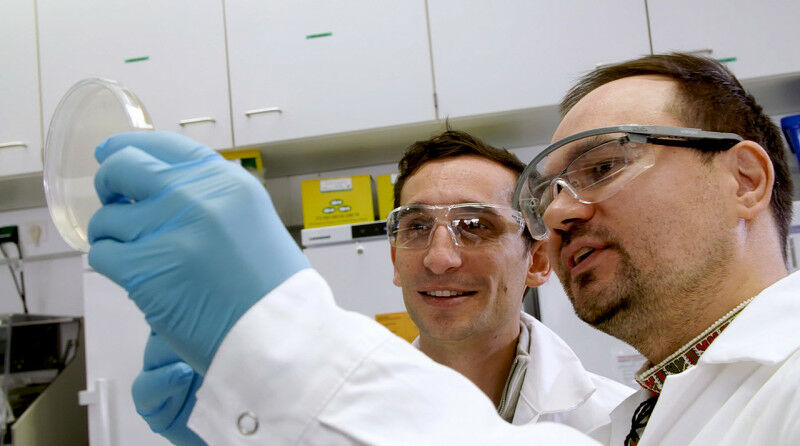博文
新型基因剪刀
||
新型基因剪刀
诸平
Chase Beisel (center) and Oleg Dmytrenko in the HIRI lab.
据德国维尔茨堡大学(University of Würzburg)2023年1月5日报道,像一把瑞士军刀( Swiss army knife):来自德国和美国的研究人员发现了新型CRISPR基因剪刀(New Type of Gene Scissors)。相关研究于2023年1月4日已经在《自然》(Nature)杂志网站发表。详见:
Oleg Dmytrenko, Gina C. Neumann, Thomson Hallmark, Dylan J. Keiser, Valerie M. Crowley, Elena Vialetto, Ioannis Mougiakos, Katharina G. Wandera, Hannah Domgaard, Johannes Weber, Thomas Gaudin, Josie Metcalf, Benjamin N. Gray, Matthew B. Begemann, Ryan N. Jackson, Chase L. Beisel. Cas12a2 elicits abortive infection through RNA-triggered destruction of dsDNA. Nature, Published: 04 January 2023. DOI: 10.1038/s41586-022-05559-3. https://www.nature.com/articles/s41586-022-05559-3
参与此项研究的有来自德国维尔茨堡亥姆霍兹感染研究中心(Helmholtz Centre for Infection Research, Würzburg, Germany)、德国维尔茨堡大学(University of Würzburg, Germany);美国犹他州立大学(Utah State University, Logan, UT, USA)以及美国密苏里州本森山公司(Benson Hill, Inc.,Missouri)的研究人员。
Jack P. K. Bravo, Thomson Hallmark, Bronson Naegle, Chase L. Beisel, Ryan N. Jackson, David W. Taylor. RNA targeting unleashes indiscriminate nuclease activity of CRISPR–Cas12a2. Nature, Published: 04 January 2023. DOI: 10.1038/s41586-022-05560-w. https://doi.org/10.1038/s41586-022-05560-w
参与此项研究的有来自美国德克萨斯州立大学奥斯汀分校(University of Texas at Austin, Austin, TX, USA)、美国犹他州立大学、美国奥斯汀戴尔医学院(Dell Medical School, Austin, TX, USA);德国维尔茨堡亥姆霍兹感染研究中心(Helmholtz Centre for Infection Research, Würzburg, Germany)以及德国维尔茨堡大学(University of Würzburg, Germany)的研究人员。
像人类一样,细菌和古细菌也会受到病毒的攻击。这些微生物已经发展出针对其病原体的免疫防御策略。CRISPR-Cas系统等细菌防御系统具有多种蛋白质和功能,可帮助细菌保护自身免受外来入侵者的侵害。这种防御基于一个共同的机制:作为“向导RNA(guide RNA)”的CRISPR核糖核酸 (CRISPR ribonucleic acid 简称crRNA) 有助于检测外来基因组的区域,例如病毒的DNA,以进行靶向切割。由crRNA引导的CRISPR 相关 (CRISPR-associated 简称Cas) 核酸酶可以像一把剪刀一样切割其目标:人类在许多技术中利用的一种自然策略。
“考虑到不同的核酸酶(nucleases)已被很好地转化为新技术和改进技术,这一领域的任何发现都可能为社会带来新的好处,”蔡斯·贝赛尔(Chase Beisel)说,他描述了他在维尔茨堡亥姆霍兹研究所基于RNA的感染研究(Würzburg Helmholtz Institute for RNA-based Infection Research简称HIRI)实验室的研究动机。该研究所是布伦瑞克·亥姆霍兹感染研究中心(Braunschweig Helmholtz Centre for Infection Research)与维尔茨堡大学 {Julius-Maximilians-Universität (JMU) in Würzburg}合作的一个站点。蔡斯·贝赛尔与美国密苏里州本森山公司(Benson Hill, Inc.,Missouri)的马修·贝格曼(Matthew Begemann) 和美国犹他州立大学的瑞恩·杰克逊(Ryan Jackson)一起发起了针对一组特定CRISPR-Cas系统的当前研究。其研究结果于2023年1月4日已经在著名的《自然》(Nature)杂志网站发表,并伴随着第二个团队的详细结构分析,该团队也由瑞恩·杰克逊和德克萨斯大学的大卫·泰勒(David Taylor)领导。详见原文。
不同于任何其他已知的 CRISPR 核酸酶(Unique from any other known CRISPR nuclease)
上述研究论文(DOI: 10.1038/s41586-022-05559-3)的第一作者、HIRI 博士后奥列格·戴梦琴科(Oleg Dmytrenko)说:“我们正在探索最初与Cas12a结合在一起的CRISPR核酸酶,这些核酸酶通过识别和切割侵入性DNA来保护细菌。一旦我们发现了更多它们,我们就意识到它们与 Cas12a的差异足以保证进行更深入的研究。这项探索让我们发现,这些我们称为Cas12a2的核酸酶不仅与Cas12a有很大不同,而且与任何其它已知的CRISPR核酸酶也有很大不同。”
关键区别在于它们的防御作用机制。当Cas12a2识别侵入性RNA时,核酸酶会对其进行切割,但也会破坏细胞内的其它RNA和DNA,从而损害其生长并限制感染的传播。奥列格·戴梦琴科博士后说:“一般来说,这种中止感染的防御策略在细菌中是已知的。其它一些 CRISPR-Cas系统以这种方式工作。然而,以前没有观察到一种基于CRISPR的防御机制,它依赖于单一核酸酶来识别入侵者并降解细胞DNA和RNA。”
这项研究得到了欧洲研究委员会(European Research Council简称ERC) 整合奖(ERC Consolidator Award)、德国联邦颠覆性创新机构(German Federal Agency for Disruptive Innovation简称SPRIND)、亥姆霍兹感染研究中心的Pre-4D项目(Pre-4D program of the Helmholtz Centre for Infection Research)、美国国立卫生研究院(National Institutes of Health)以及韦尔奇基金会(Welch Foundation)的资助。
上述介绍,仅供参考。欲了解更多信息,敬请注意浏览原文或者相关报道。
Abstract (DOI: 10.1038/s41586-022-05559-3)
Bacterial abortive-infection systems limit the spread of foreign invaders by shutting down or killing infected cells before the invaders can replicate1,2. Several RNA-targeting CRISPR–Cas systems (that is, types III and VI) cause abortive-infection phenotypes by activating indiscriminate nucleases3,4,5. However, a CRISPR-mediated abortive mechanism that leverages indiscriminate DNase activity of an RNA-guided single-effector nuclease has yet to be observed. Here we report that RNA targeting by the type V single-effector nuclease Cas12a2 drives abortive infection through non-specific cleavage of double-stranded DNA (dsDNA). After recognizing an RNA target with an activating protospacer-flanking sequence, Cas12a2 efficiently degrades single-stranded RNA (ssRNA), single-stranded DNA (ssDNA) and dsDNA. Within cells, the activation of Cas12a2 induces an SOS DNA-damage response and impairs growth, preventing the dissemination of the invader. Finally, we harnessed the collateral activity of Cas12a2 for direct RNA detection, demonstrating that Cas12a2 can be repurposed as an RNA-guided RNA-targeting tool. These findings expand the known defensive abilities of CRISPR–Cas systems and create additional opportunities for CRISPR technologies.
Abstract (DOI: 10.1038/s41586-022-05560-w)
Cas12a2 is a CRISPR-associated nuclease that performs RNA-guided, sequence-nonspecific degradation of single-stranded RNA, single-stranded DNA and double-stranded DNA following recognition of a complementary RNA target, culminating in abortive infection1. Here we report structures of Cas12a2 in binary, ternary and quaternary complexes to reveal a complete activation pathway. Our structures reveal that Cas12a2 is autoinhibited until binding a cognate RNA target, which exposes the RuvC active site within a large, positively charged cleft. Double-stranded DNA substrates are captured through duplex distortion and local melting, stabilized by pairs of ‘aromatic clamp’ residues that are crucial for double-stranded DNA degradation and in vivo immune system function. Our work provides a structural basis for this mechanism of abortive infection to achieve population-level immunity, which can be leveraged to create rational mutants that degrade a spectrum of collateral substrates.
https://blog.sciencenet.cn/blog-212210-1370963.html
上一篇:酷酷的制冷新方法
下一篇:只需轻按一下开关即可解决炎症?
